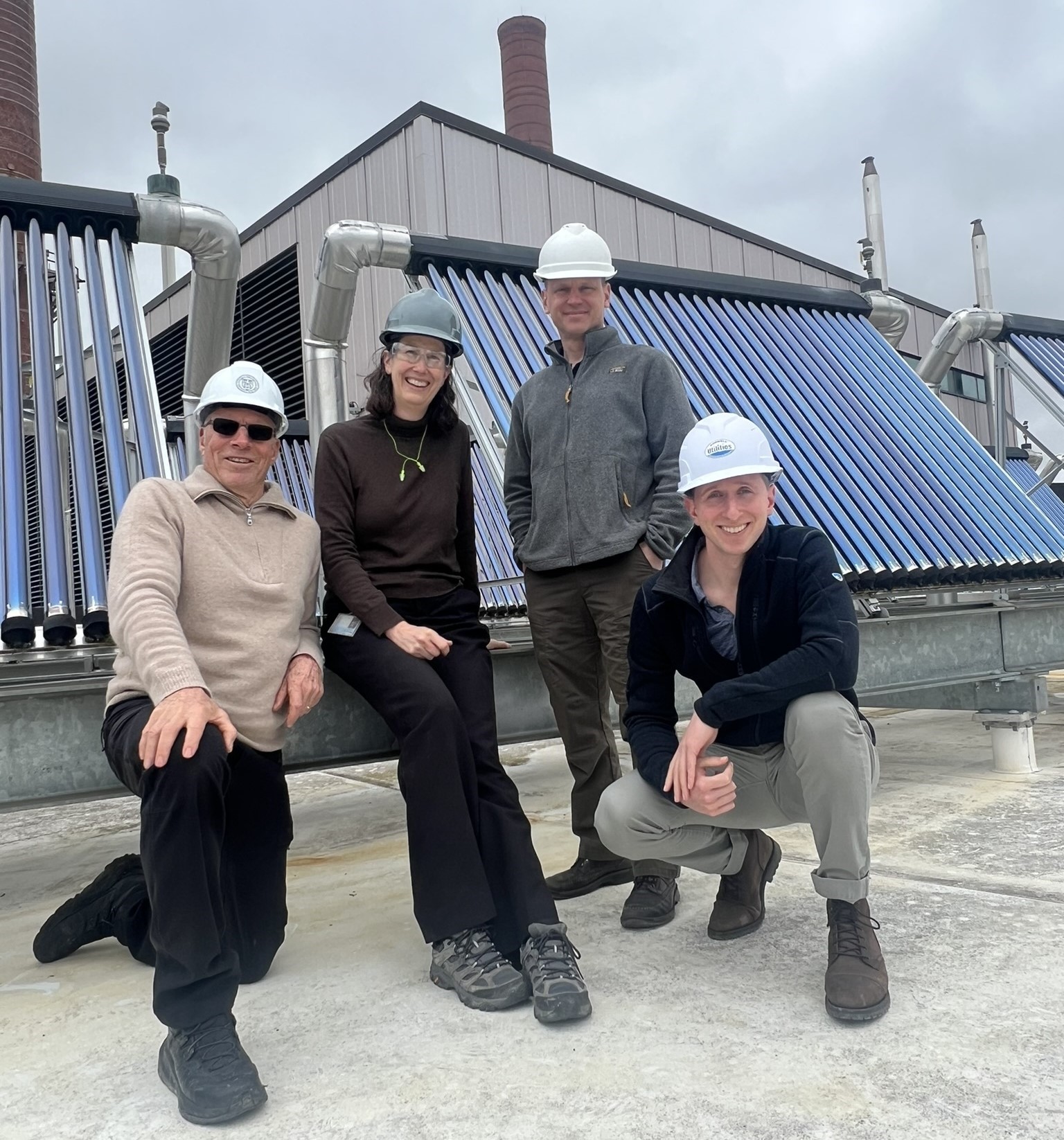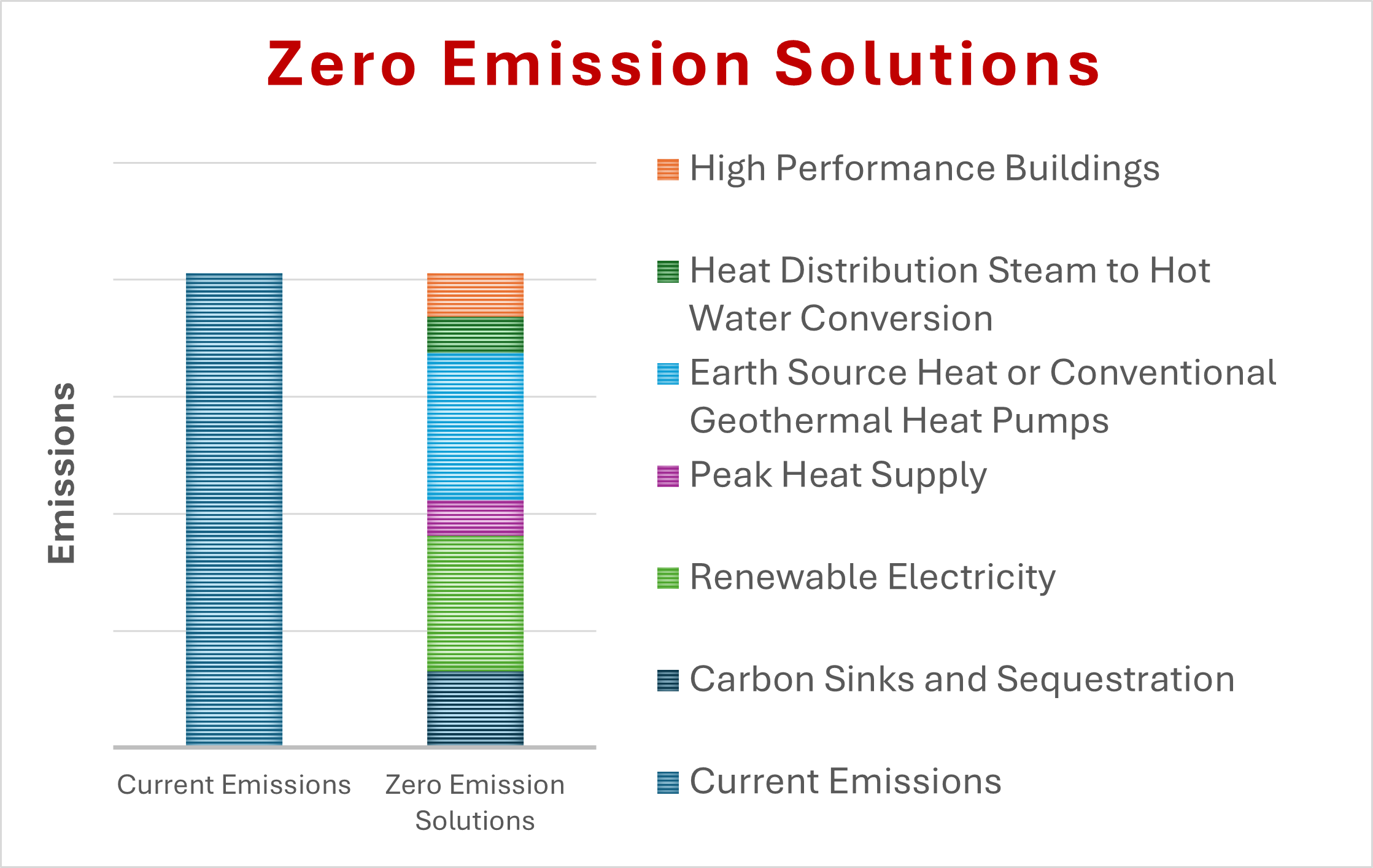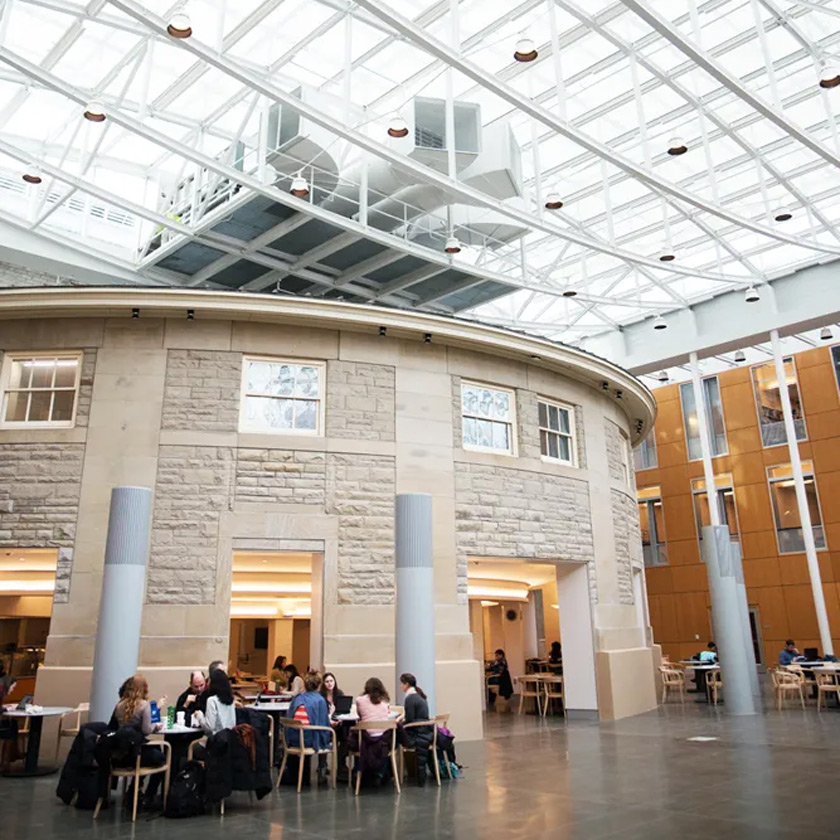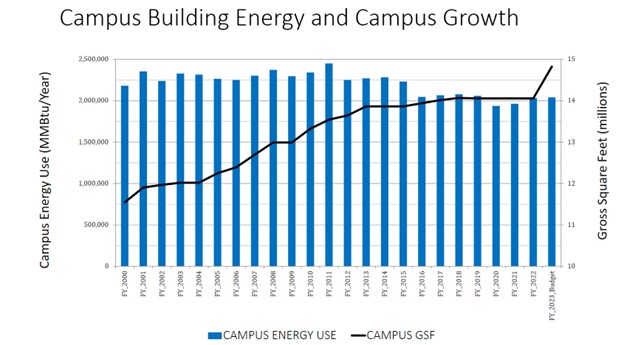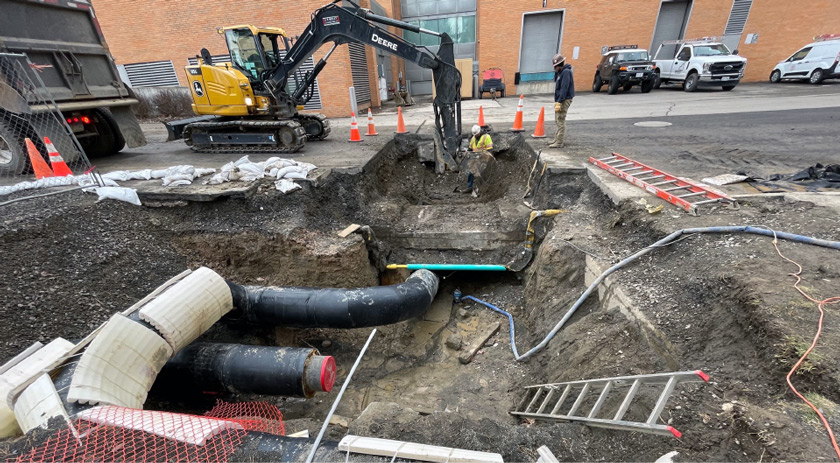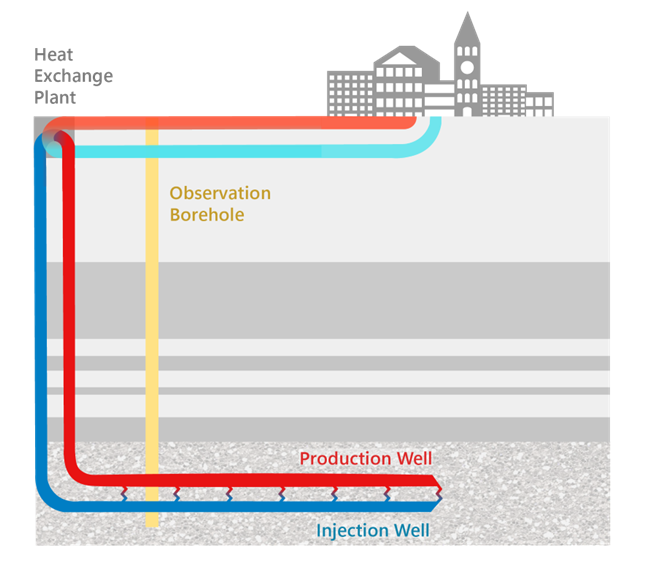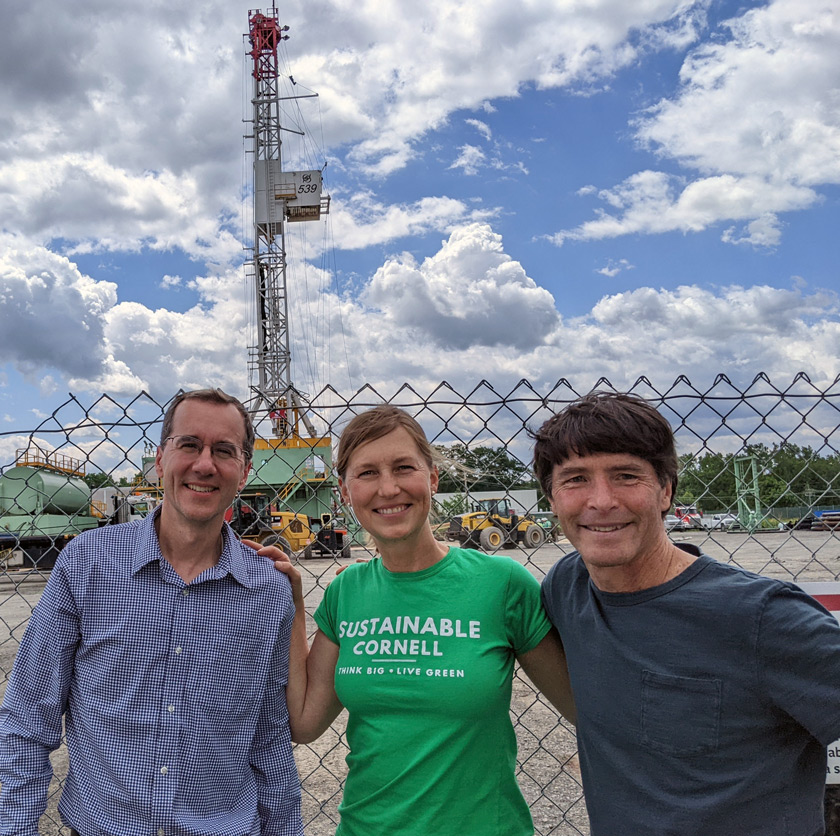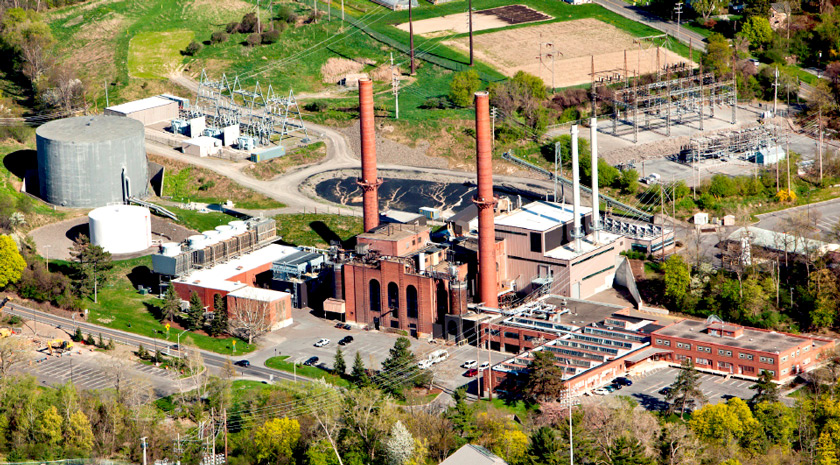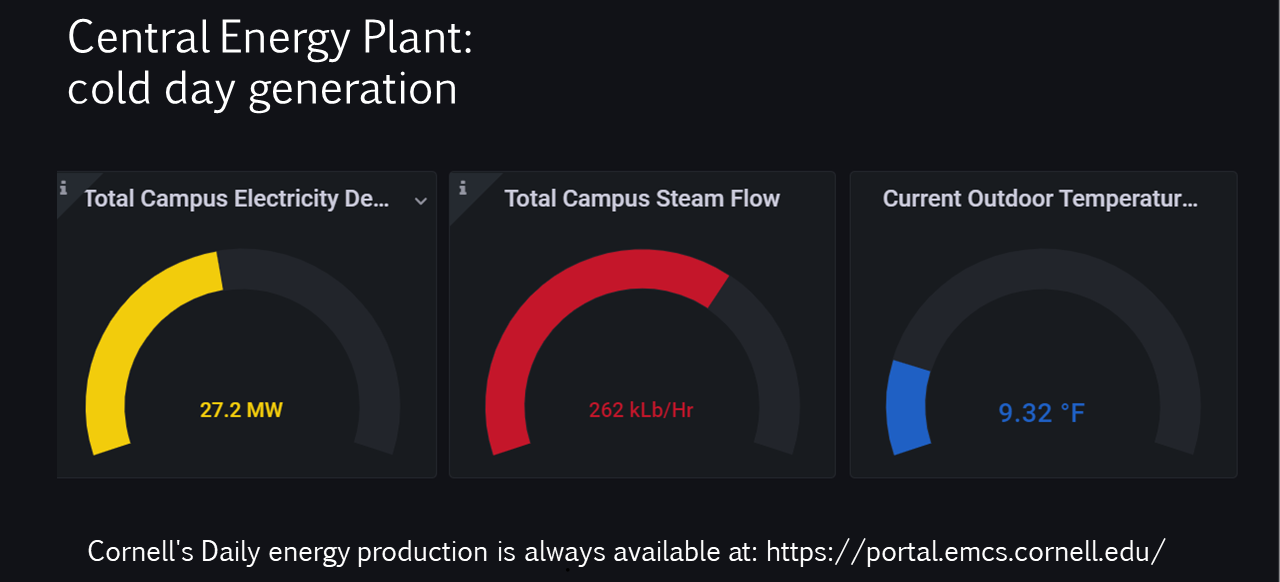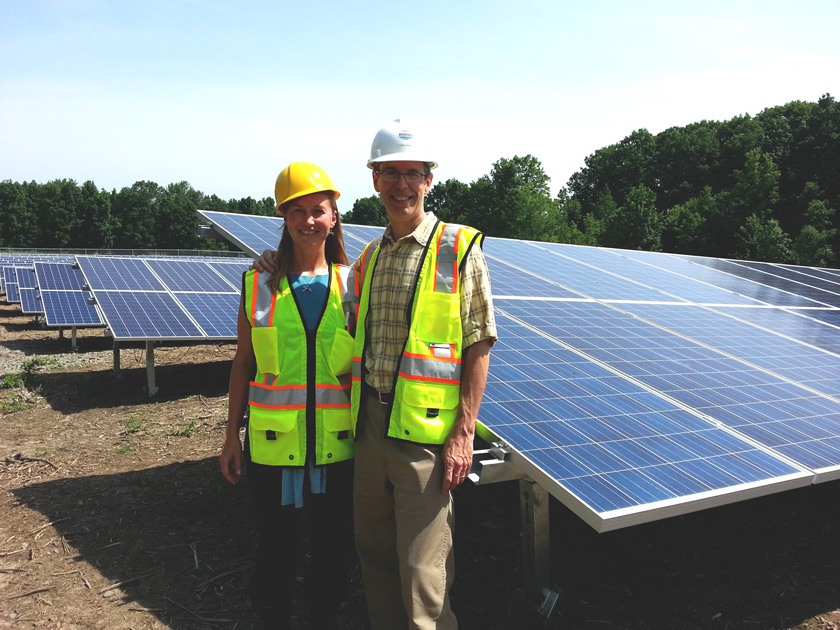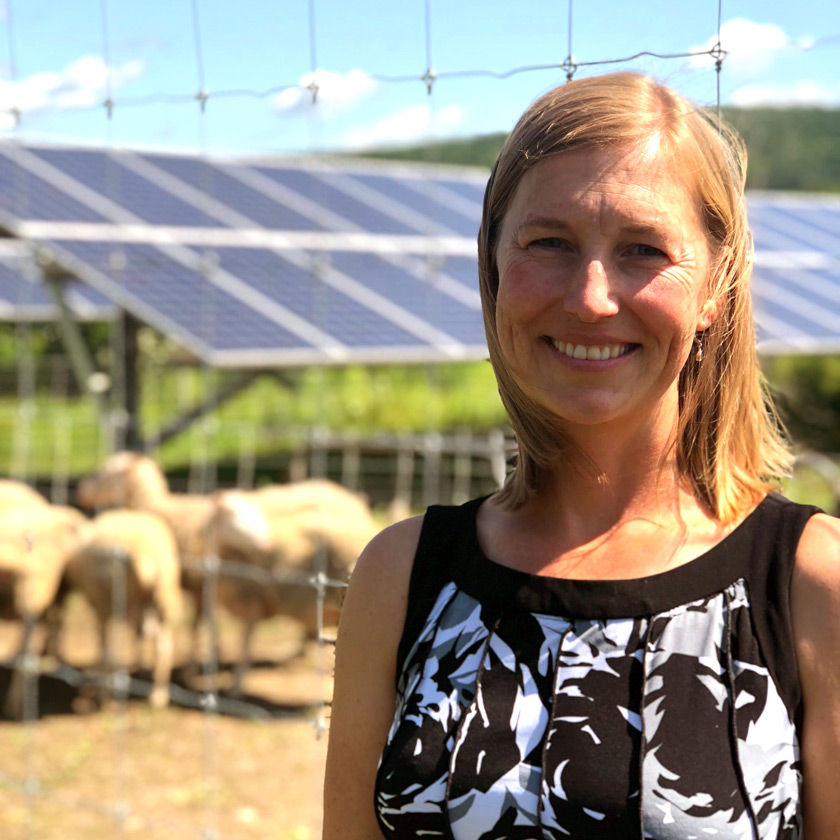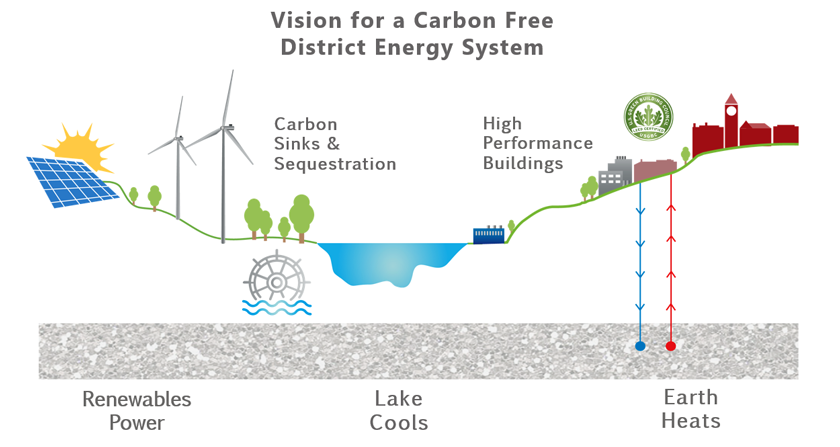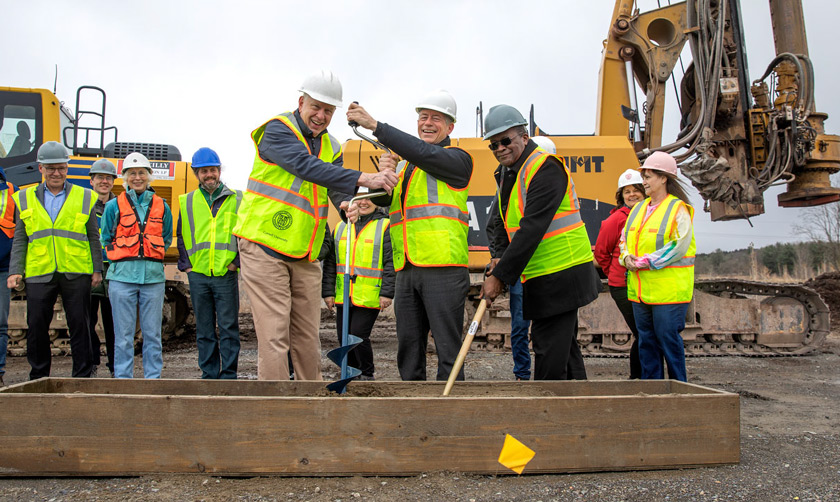Cornell’s Climate Action Plan is the university’s roadmap for achieving net zero emissions by 2035. The plan was originally adopted in 2009. It is a ‘living’ document—which has been updated to incorporate emerging technologies and take advantage of policy, market, and educational opportunities.
As Cornell tackles the day-to-day challenges of greening operations across its Ithaca campus, the university has embraced a culture of sustainability. The effort has brought together staff, faculty, students, and public and private sector partners for an all-hands-on-deck collaboration to avoid, reduce, and replace emissions. Together, Cornellians are finding ways to reduce waste in dining halls, conserve energy in teaching and research spaces, and innovate new technologies for cooling and heating campus.
“In the minds of those of us who have been working on this since 2009, the yes (we can do this) has always been there.” —Sarah Carson, director of the Campus Sustainability Office
President Martha E. Pollack has identified sustainability as a university priority. Every incoming student is asked to complete a Mission Sustainability module before they arrive on campus, as part of their orientation to Cornell. And Cornell is the only institution of higher education in the world to receive the highest possible sustainability rating—STARS Platinum—for four consecutive years.
According to Sarah Carson, director of the Campus Sustainability Office, Cornell is now well positioned to meet its 2035 net zero emissions goal. She emphasizes that it’s going to be a big lift: “Institutional commitment at every level is critical if we’re going to pull this off.”
Yes, we can!
Sarah is one of a handful of people who have been there since the beginning, diligently working behind the scenes to implement the Climate Action Plan (CAP). She first came to Cornell in 1997 for a position monitoring the university’s new Lake Source Cooling pipeline. She recalls hiking up and down Gun Hill “way too many times.”
She originally intended to enroll in the employee degree program and attend Cornell Law School while working for the university. But that goal soon faded as Sarah realized that the work she was doing to advance sustainability at Cornell was exactly the kind of work she aspired to.
“The positions I’ve been in and the people I’ve worked with have all tried to move things in the right direction. In the minds of those of us who have been working on the CAP since 2009, the yes (we can do this) has always been there. We’ve been slowly chipping away at the plan.”
Follow along as Sarah walks us through each action and explains how the six key zero emission solutions work together to get us across the finish line to meet Cornell's carbon neutrality goal.
In general, these actions fall into three buckets: to avoid, reduce, and replace emissions. We’ll start with actions that avoid wasting energy.
High Performance Buildings
The high performance buildings solution will mitigate about 10% of remaining emissions and is all about avoiding energy use by increasing energy efficiency. Since the inception of the Climate Action Plan, Cornell has employed a team of experts to manage its successful Energy Conservation Initiative (ECI). These staff members work on retrofitting existing campus buildings to improve the heating and air conditioning systems, replace lighting systems, and improve the shells of building to reduce leakage (through better insulation, for example).
The team follows a regular schedule for recommissioning buildings on campus, returning every two to three years to ensure the building HVAC controls and systems are working as designed, follow up on maintenance, and identify capital improvements to improve energy performance.
They have continued to refine heat recovery systems, especially in labs, and have recently realized significant savings (of $670,000 annually) in the Biotechnology Building. They also consult on the construction of new buildings on campus to ensure that they’re as energy efficient as possible.
“If you do the financial math, they more than pay for themselves in terms of the energy savings,” Sarah explains.
Sarah cites this impressive metric to demonstrate success: “If we look
all the way back to the year 2000 and consider that the campus has expanded by about 20% over the past 24 years, we can see that we’re actually using less energy today than we were in 2000.”
All of the ECI projects are documented in a public dashboard that includes energy, greenhouse gas, and financial savings for each project.
She says that one takeaway from this energy conservation work is that people’s behavior still really matters. When Cornell community members close the fume hoods in their labs when they’re not in use, and unplug their 'cozy toes' heaters when they leave work, it makes a significant difference in energy savings.
Convert to Hot Water for Heat Distribution
Much of the Ithaca campus is connected to what’s called a district energy system via many miles of underground pipes. This system delivers electricity, heating, and cooling from the central energy plant to buildings in the network, meaning that these buildings do not have individual boilers or AC units.
Currently, steam from the central power plant circulates through these pipes, delivering heat to campus buildings. As this super-hot steam travels through the system, there’s roughly a 20% loss of energy. By replacing the steam with hot water, the inefficiency will be reduced—resulting in overall emissions reductions of about 8%.
“Hot water is a better conductor for campus heating than steam because it loses less heat to the environment,” Sarah notes. Additionally, she says that parts of the campus steam system are 100 years old. Replacing them with new hot water pipes that are better insulated will further reduce environmental losses and increase the overall efficiency of the system.
A hot water distribution system is necessary for Earth Source Heat—a renewable heat source that Cornell is pursuing (and the next key action on the bar chart). Earth Source Heat would generate hot water, not steam, and so this is another reason why Cornell is converting from steam to a hot water distribution system.
“The angels are in the details,” Sarah observes. “We are carefully stitching all of this infrastructure work together over the next several years, so we can convert to hot water without dropping service or without having all the routes to any building dug up as we're replacing pipes, and so we can leverage existing assets with lots of remaining useful life.”
Earth Source Heat
Since 2009, Earth Source Heat has been a key piece of Cornell’s
Climate Action Plan—because it will allow the university to transition away from using fossil fuels to heat the Ithaca campus, and mitigate about 30% of remaining greenhouse gas emissions. Instead, well pairs would be drilled down to where the internal heat of the Earth is much hotter than comfortable air temperatures. Water would be pumped down one well and would flow through various fissures and channels in the rock where it is naturally heated. The resulting hot water would be drawn up into a second well and pumped to a heat exchange facility on the surface to heat a secondary loop that distributes hot water to campus buildings and facilities. When it was first proposed 15 years ago, the feasibility of this technology was a big unknown. It was unclear whether the subsurface temperature was hot enough to heat the campus or whether we could seamlessly incorporate this heat source into campus infrastructure.
In 2022, the university used a $7.2 million grant from the U.S. Department of Energy to drill a two-mile deep exploratory well, the Cornell University Borehole Observatory (CUBO), to assess subsurface temperatures and other feasibility parameters.
Data from CUBO has now been analyzed and the results are promising: the subsurface temperature is hot enough. The next step is to determine the permeability of the most promising rock layers, including the crystalline basement rock. This is the layer of Earth at the bottom of the borehole. We need to make sure that enough water can percolate through the rocks, absorb heat, and be pumped back up to the surface to heat campus buildings. A phase two of feasibility testing is proposed.
If the next phase of CUBO results prove satisfactory, this will be a huge win for Cornell. While a project using similar technology is operating in the western U.S., no one has developed an enhanced geothermal project on the East Coast.
Earth Source Heat (ESH) is expected to be many times more efficient than heat pumps. The relatively high temperature of the system means ESH could be used to directly heat the campus using only enough electricity to pump the hot water around. ESH also eliminates the need to rely on refrigerants associated with conventional ground and air source heat pumps. These refrigerants are among the most potent greenhouse gases, Sarah explains.
“You can an put an air source or ground source heat pump in your home, and for every unit of electricity you put into the system, you might get 3, 4, 5, or 6 units of heating or cooling out of it. For Earth Source Heat, we think this number (the coefficient of performance) will be about 30. That’s a huge increase!”
She believes this new technology is truly ‘groundbreaking’ and could change everything if it works. Large population centers—like Cornell’s campus—could rely on Earth Source Heat rather than conventional ground source heat pumps.
“If Cornell uses conventional heat pump technology, we might need as many as 10,000 ground source heat pump wells, plus all of the associated casing, piping, and embodied carbon. And we might double our electricity consumption to power them all. Our campus is already 1-1,000th of the State of New York’s electricity demand. So that's a lot of electricity, right?”
Sarah explains that commercial scale heat pumps are still the best back-up option to provide hot water for the campus’ district energy system if ESH is not viable.
Peak Heat Supply
Most people who have lived in cold climates are familiar with the concept of peak heating demand. On days when the temperature drops into single digits or lower, everyone needs more heat at the same time to keep their spaces comfortable. The simultaneous demand for more heat peaks at a level way above the baseline (the average capacity that the system generates), but only for a short time.
Mitigating emissions associated with the Ithaca campus’s peak heating demand addresses about another 7% of remaining emissions. Even if Cornell transitions to Earth Source Heat, there will still be days when heating demand exceeds baseline generation.
Sarah says there are at least two complementary ways to approach this challenge: one is load shedding to reduce demand. So, instead of heating a space to 70°F, Cornell might choose to lower the temperature to 65°F on peak heating days.
The second approach is to generate peak heat supply using other renewable sources.
“We haven't ruled anything out,” Sarah observes. “We're looking at things like green hydrogen, or biofuels, or potentially electric steam boilers,” she says.
“That’s the fun part of this—we don't want to be locked into something, but instead remain open to emerging technologies.”
Renewable Electricity
Cornell currently meets about 20% of its electric demand through solar projects and the campus hydroelectric plant. By 2027, the university will be positioned to meet 100% of its electrical needs through renewable generation.
Cornell has agreements for two large-scale solar projects in New York State to purchase the power that they generate. Planned to start by 2027, these projects combine with existing solar and hydro resources to make as much renewable electricity as the campus uses. They will eliminate nearly another 30% of remaining emissions.
Sarah explains that the timing of this transition hinges both on the campus switching to renewable heat and on the NY power grid transitioning to 100% clean and renewable generation.
“As long as we have to heat the campus with gas, it makes sense for us to keep using the electricity that is already being generated in the combined heat and power plant, rather than just wasting it,” she says.
Because the state’s existing solar, hydro, wind and nuclear plants are already running at their maximum capacity, the power generator that typically ramps up or down with changes in grid demand in the Ithaca area is a natural gas power plant in Oswego, New York. This plant is generating electricity using fossil fuel and not renewables, and the emissions factor for this energy is three times higher than the upstate NY average, and 50% higher than Cornell’s co-generated power. Switching the campus to grid power must be done strategically, in concert with statewide progress, so that it does not have the impact of causing even more gas to be burned in the near term.
What few people realize is that Cornell has played a pivotal role in paving the way for renewable energy projects in the state. For more than a decade, Sarah and her colleagues have advocated for the policy changes necessary to make solar projects economically and logistically viable in New York.
“I think we really kicked down the door for renewable energy generation from the voluntary market in the state,” she says.
In 2012 Sarah petitioned the state’s Public Utilities Commission to allow Cornell’s first solar farm to interconnect to the electric grid—and this successful decision has since been dubbed ‘the Cornell Ruling.’
“That ruling really paved the way for all of the community solar and the distributed scale solar that's out there now,” she notes.
“I think that we've had to do something like that for every renewable project that we've built, whether it was changing the local zoning or pushing for statewide market mechanisms to help displace natural gas. Cornell has done a lot of work behind the scenes that's made these things possible.”
Carbon Sinks and Sequestration
While Cornell has plans to avoid or reduce most of its emissions, there is a portion of emissions from university related transportation that may be difficult to control. These emissions are mostly associated with daily commuting to and from campus and with university funded air travel.
Sarah hopes that strategies like hybrid work, increased use of public transit, and electrification of personal vehicles will make a dent in commuting emissions. But she is not anticipating that Cornell will be able to eliminate all its transportation-related emissions by 2035.
To offset these emissions (representing about 15% of the overall strategy), Cornell is seeking to improve the ways it manages the roughly 20,000 acres of land it owns across New York State. The goal is to increase the capacity of these properties to sequester carbon through changes in land management.
For the past two years, a working group of Cornell staff, faculty, and students has been exploring different forest, turf, agriculture, and soil management practices to identify the most promising strategies. The group is now interviewing university land managers to get their firsthand input on various options—to come up with specific best practices for each parcel of land.
Sarah is excited both about the process and the future prospects.
“We've been going parcel by parcel, acre by acre, asking the land managers, ‘Can we do this, or this, or this?’ And they’ve been super helpful. We've gotten some really pragmatic feedback, including some new ideas that we hadn't thought about trying before. It’s been a really inspiring exercise,” she says.
The working group hopes to compile all of the recommendations this summer. Once they create a menu of what’s possible on each parcel, they’ll begin to dig in and implement these best practices.
Moving in the same direction
As Sarah reflects on all that’s been accomplished over the past 15 years, she acknowledges that one of the biggest challenges has been managing change. She points out that, in many cases, community members have questioned why the university is pursuing a plan that relies on emerging technologies rather than turning to conventional solutions.
“A lot of folks are feeling really frightened about the rate of climate impacts,” she says. “They wonder whether it’s the right thing to be trying out Earth Source Heat. Explaining why we've made the choices that we've made is important—so that people can see that we’re all moving in the same direction.”
Sarah and her team use a variety of media to keep the community informed, including email, social media channels, virtual and face-to-face meetings.
“Communicating in a lot of different ways matters,” she says, “because it's getting harder and harder to break into people's algorithms.”
Coming to consensus around the elements of the plan helps smooth the way when there are disruptions on campus (from actions like digging up old steam pipes, for example). Prior to breaking ground for CUBO, Sarah and her team invited stakeholders from the broader community to serve on an advisory board for Earth Source Heat project.
“The model that we used for this community advisory team has been very successful,” she observes. “We’re trying to bring people in early in the process—to hear their questions and talk about options—as opposed to just coming out with an announcement that this is what we’re doing. I think that the process of engaging stakeholders has been super important.”


